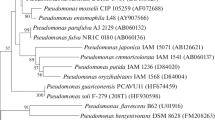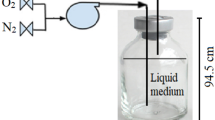Abstract
2-Chloro-4-methylphenoxyacetate is not a growth substrate for Alcaligenes eutrophus JMP 134 and JMP 1341. It is, however, being transformed by enzymes of 2,4-dichlorophenoxyacetic acid metabolism to 2-chloro-4-methyl-cis, cis-muconate, which is converted by enzymatic 1,4-cycloisomerization to 4-carboxymethyl-2-chloro-4-methylmuconolactone as a dead end metabolite. Chemically, only 3,6-cycloisomerization occurs, giving rise to both diastereomers of 4-carboxychloromethyl-3-methylbut-2-en-4-olide. Those lactones harbonring a chlorosubstituent on the 4-carboxymethyl side chain were surprisingly stable under physiological as well as acidic conditions.
Similar content being viewed by others
References
Bradford MM (1976) A rapid and sensitive method for the quantitation of protein utilizing the principle of protein-dye binding. Anal Biochem 72: 248–254
Bruce NC, Cain RB (1988) β-Methylmuconolactone, a key intermediate in the dissimilation of methylaromatic compounds by a modified 3-oxoadipate pathway evolved in nocardioform actinomycetes. FEMS Microbiol Lett 50: 233–239
Cain RB, Kirby GW, Rao GV (1989) Stereochemistry of enzymic cyclisation of 3-methyl-cis,cis-muconic acid to form 3-and 4-methylmuconolactone. Chem Commun (J Chem Soc Sect D) 21: 1629–1631
Catelani D, Fiecchi A, Galli E (1971) (+)-γ-Carboxymethyl-γ-methyl Δa-butenolide a 1,2-ring-fission product of 4-methyl-catechol by Pseudomonas desmolyticum. Biochem J 121:89–92
DeBoer TJ, Bakker HJ (1954) A new method for the preparation of diazomethane. Rec Trav Chim 73: 229–234
Don RH, Pemberton JM (1981) Properties of six pesticide degradation plasmids isolasted from Alcaligenes paradoxus and Alcaligenes eutrophus. J Bacteriol 145: 681–686
Dorn E, Knackmuss HJ (1978a) Chemical structure and biodegradability of halogenated aromatic compound: two catechol 1,2-dioxygenases from a 3-chlorobenzoate grown pseudomonad. Biochem J 174: 73–84
Dorn E, Knackmuss HJ (1978b) Chemical structure and biodegradability of halogenated aromatic compounds: substituent effects on 1,2-dioxygenation of catechol. Biochem J 174: 85–94
Dorn E, Hellwing M, Reineke W, Knackmuss HJ (1974) Isolation and characterization of a 3-chlorobenzoate degrading pseudomonad. Arch Microbiol 99: 61–70
Hartmann J, Reineke W, Knackmuss HJ (1978) Metabolism of 3-chloro-, 4-chloro-and 3,5-dichlorobenzoate by a pseudomonad. Appl Environ Microbiol 37: 421–428
Knackmuss HJ, Hellwing M, Lackner H, Otting W (1976) Cometabolism of 3-methylbenzoate and methylcatechols by a chlorobenzoate utilizing Pseudomonas: accumulation of (+)-2,5-dihydro-4-methyl-and (+)-2,5-dihydro-2-methyl-5-oxo-fu-ran-2-acetic acid. Eur J Appl Microbiol 2: 267–276
Kozarich JW, Chari RVJ, Ngai KL, Ornston LN (1986) Strereochemistry of muconate cycloisomerases. In: Frey PA (ed) Mechanisms of enzymatic reactions: stereochemistry. Elsevier Science Publishing, New York, pp. 233–246
Kuhm AE, Schlömann M, Knackmuss HJ, Piper DH (1990) Purification and characterization of dichloromuconate cycloisomerase from Alcaligenes eutrophus JMP 134. Biochem J 266: 877–883
Kukor JE, Olsen RH, Siak JS (1989) Recruitment of a chromosomally encoded maleylacetate reductase for degradation of 2,4-dichlorophenoxyacetic acid by plasmid pJP4. J Bacteriol 171: 3385–3390
Liu T, Chapman PJ (1984) Purification and properties of a plasmid encoded 2,4-dichlorophenol hydroxylase. FEMS Microbiol Lett 173: 314–318
Miller DJ (1981) Toluate metabolite in nocardioform Actinomycetes: utilization of the enzymes of the 3-oxoadipate pathway for the degradation of methyl-substituted analogues. Actinomycetes. Zentralbl Bakt 11 [Suppl]: 355–360
Ngai KL, Kallen RG (1983) Enzymes of the β-ketoadipate pathway in Pseudomonas putida. Primary and secondary kinetic and equilibrium deuterium isotope effects upon the interconversion of (+)-muconolactone to cis,cis-muconate catalyzed by cis,cis-muconate cycloisomerase. Biochemistry 22: 5231–5236
Pieper DH, Engesser KH, Don RH, Timmis KN, Knackmuss HJ (1985) Modified ortho-cleavage pathway in Alcaligenes eutrophus JMP 134 for the degradation of 4-methylcatechol. FEMS Microbiol Lett 29: 63–67
Pieper DH, Reineke W, Engesser KH, Knackmuss HJ (1988) Metabolism of 2,4-dichlorophenoxycetic acid, 4-chloro-2-methylphenoxyacetic acid and 2-methylphenoxyacetic acid by Alcaligenes eutrophus JMP 134. Arch Microbiol 150: 95–102
Pieper DH, Engesser KH, Knackmuss HJ (1989) Regulation of catabolic pathways of phenoxyacetic acids and phenols in Alcaligenes eutrophus JMP 134. Arch Microbiol 151: 365–371
Pieper DH, Engesser KH, Knackmuss HJ (1990) (+)-4-Carboxymethyl-2,4-dimethylbut-2-en-4-olide as dead-end metabolite of 2,4-dimethylphenoxyacetic acid or 2,4-dimethylphenol by Alcaligenes eutrophus JMP 134. Arch Microbiol 154: 600–604
Piper DH, Stadler-Fritzsche K, Schlömann M, Knackmuss HJ (1992) Metabolism of 2-chloro-4-methylphenoxyacetate by Alcaligenes eutrophus JMP 134: implications for the degradation of chloro-and methylaromatis via ortho-clevage. In: Galli E, Silver S, Withold B (eds) Pseudomonas: molecular biology and biotechnology. American Society for Microbiology, Washington, DC, pp. 277–291
Powlowski JB, Dagley S (1985) β-Ketoadipate pathway in Trichosporon cutaneum modified for methylsubstituted metabolites. J Bacteriol 163: 1126–1135
Reineke W, Knackmuss HJ (1984) Microbial metabolism of haloaromatics: isolation and properties of a chlorobenzene-degrading bacterium. Appl Environ Microbiol 47: 395–402
Schlömann M, Fischer P, Schmidt E, Knackmuss HJ (1990a) Enzymatic formation, stability, and spontaneous reations of 4-fluoromuconolactone, a metabolite of thebacterial degradation of 4-fluorobenzoate. J Bacteriol 172: 5119–5129
Schlömann M, Pieper DH, Knackmuss HJ (1990b) Enzymes of haloaromatic degradation: variations of Alcaligenes on a theme by Pseudomonas. In: Silver S, Chakrabarty AM, Iglewski B, Kaplan S (eds) Pseudomonas: biotransformations, pathogenesis, and evolving biotechnology. American Society for Microbiology, Washington, DC, pp. 185–196
Schlömann M, Schmidt E, Knackmuss HJ (1990c)_Different types of dienelactone hydrolase in 4-fluorobenzoate utilizing bacteria. J Bacteriol 172: 5112–5118
Schmidt E, Knackmuss HJ (1980) Chemical structure and biodegradability of halogenated armatic compounds. Conversion of chlorinated muconic acids into maleylacetic acid. Biochem J 192: 339–347
Schmidt E, Remberg G, Knackmuss HJ (1980) Chemical structure and biodegradability of halogenated aromatic compounds. Halogenated muconic acids as intermediates. Biochem J 192: 331–337
Schmidt K, Liaaen Jensen S, Schlegel HG (1963) Die Carotinoide der Thiorhodaceae I. Okenon als Hauptcarotinoid von Chromatium okenii Petry. Arch Microbiol 46: 117–126
Schreiber A, Hellwig M, Dorn E, Reineke W, Knackmuss HJ (1980) Critical reations in fluorobenzoic acid degradation by Pseudomonas sp. B13. Appl Environ Microbiol 39: 58–67
Streber W, Timmis KN, Zenk MH (1987) Analysis, cloning, and high-level expression of 2,4-dichlorophenoxyacetate monooxygenase gene tfdA of Alcaligenes eutrophus JMP 134. J Bacteriol 169: 2950–2955
Vollmer MD, Stadler Fritzsche K, Schlömann M (1993) Conversion of 2-chloromaleylactate in Alcaligenes eutrophus JMP 134. Arch Microbiol 159: 182–188
Winnacker K, Küchler L (1972) Chemische Technologie, Bd 4. Organische Technologie, Hanser, München, pp. 738–746
Author information
Authors and Affiliations
Rights and permissions
About this article
Cite this article
Pieper, D.H., Stadler-Fritzsche, K., Engesser, KH. et al. Metabolism of 2-chloro-4-methylphenoxyacetate by Alcaligenes eutrophus JMP 134. Arch. Microbiol. 160, 169–178 (1993). https://doi.org/10.1007/BF00249121
Received:
Accepted:
Issue Date:
DOI: https://doi.org/10.1007/BF00249121




